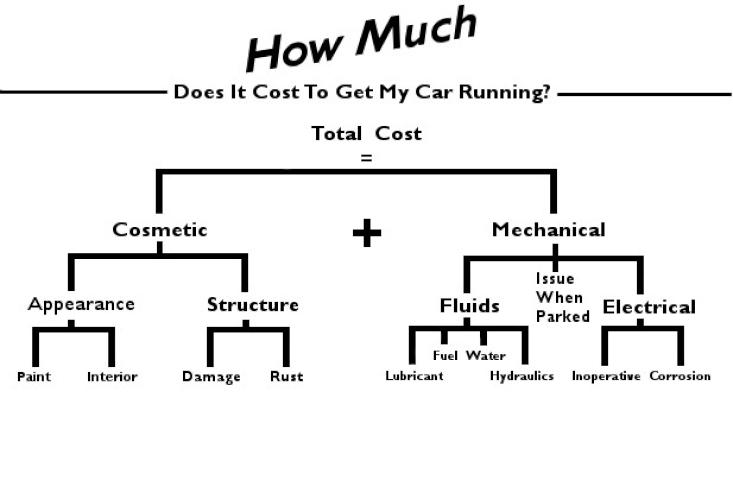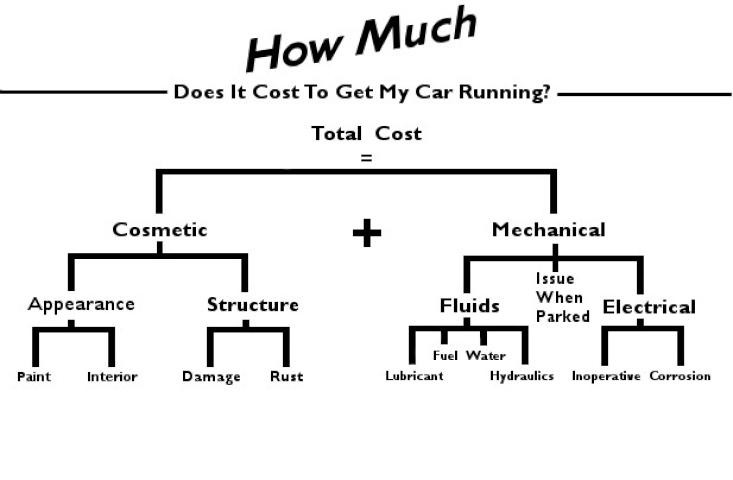A large percentage of our business is concerned with getting ‘ran when parked’ cars —or those even less fortunate— up and running for the first time in 30 or 40 years. The first question on the tip of every driver’s tongue, after the obligatory “Can you save it?” is “How much will it cost?” That question, alas, has no quick or easy answer. Nor is there an equation into which we can plug in the years of hibernation, multiplied by the number of pieces missing and divided by the total number of mice living in the trunk, to arrive at a reasonable sum.1 Anyone who does tell you that there’s an easy answer probably has some snake oil you might be interested in as well. The truth of the matter is that any estimate is at best a stab in the dark based on previous experience and factoring best and worst case scenarios. To the untrained eye, determining the right course of action to get a car back up and running is little more than voodoo. But our system isn’t nearly so complicated. We follow a very logical, tiered system. By following this system of inquiry, we make sense of the many aspects of the car and ensure that nothing is overlooked.
The Equation Behind a British Car restoration
 Figure 1. As with any complex system, breaking down a car to its component parts allows us to make sense of a large volume of information while covering all aspects of its drivability issues. This graphic is a road map to our system — a visual representation of the way we approach every car we revive from hibernation. There are two major branches of getting a car up and running—mechanical and cosmetic. The cosmetic issues can be split into those which are structural, such as rust or accident damage; and visual, which covers paint, upholstery and trim. The mechanical issues, however, are more diverse and run deeper. First, we must discover the original point of failure on the car which caused the car to be parked in the first place. Sometimes this is an obvious issue, like a front-end collision. Other times, the issue can be quite buried, stemming from an electrical or mechanical failure. Once we discover the original malfunction, we need to address the myriad issues stemming from the subsequent years of disuse. After sitting in a field for a year, ten, or thirty, any systems which rely on liquids—fuel, cooling, hydraulics and lubricants— will have degraded, possibly causing damage to the car at the same time. The electrical systems also need to be tested to find any inoperative systems or those which have corroded due to age. By now, we’ve probably created a list of observations and concerns a mile long. This list will cover every aspect of the car in question. Not every item on the list needs to be addressed immediately, but it does raise another important question: how far do you want to take your project? Do you want to get the car running well enough to get it through emissions while still needing the occasional jump on cold mornings, or do you want to turn it into a reliable daily driver? Or would you like to completely restore it, making it into a Conclave award-winner? Your answer will determine what systems we choose to tackle first, whether we use new or used parts, and a whole manner of other choices. The resulting parts and labor will determine the total cost. See? No voodoo involved, just 30+ years of experience repairing and restoring vintage British cars.
Figure 1. As with any complex system, breaking down a car to its component parts allows us to make sense of a large volume of information while covering all aspects of its drivability issues. This graphic is a road map to our system — a visual representation of the way we approach every car we revive from hibernation. There are two major branches of getting a car up and running—mechanical and cosmetic. The cosmetic issues can be split into those which are structural, such as rust or accident damage; and visual, which covers paint, upholstery and trim. The mechanical issues, however, are more diverse and run deeper. First, we must discover the original point of failure on the car which caused the car to be parked in the first place. Sometimes this is an obvious issue, like a front-end collision. Other times, the issue can be quite buried, stemming from an electrical or mechanical failure. Once we discover the original malfunction, we need to address the myriad issues stemming from the subsequent years of disuse. After sitting in a field for a year, ten, or thirty, any systems which rely on liquids—fuel, cooling, hydraulics and lubricants— will have degraded, possibly causing damage to the car at the same time. The electrical systems also need to be tested to find any inoperative systems or those which have corroded due to age. By now, we’ve probably created a list of observations and concerns a mile long. This list will cover every aspect of the car in question. Not every item on the list needs to be addressed immediately, but it does raise another important question: how far do you want to take your project? Do you want to get the car running well enough to get it through emissions while still needing the occasional jump on cold mornings, or do you want to turn it into a reliable daily driver? Or would you like to completely restore it, making it into a Conclave award-winner? Your answer will determine what systems we choose to tackle first, whether we use new or used parts, and a whole manner of other choices. The resulting parts and labor will determine the total cost. See? No voodoo involved, just 30+ years of experience repairing and restoring vintage British cars.

